TRAINING COMBAT SEQUENCES TO PREPARE FOR FREE SPARRING
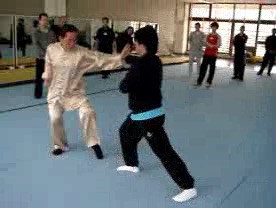 Shaolin combat application at the regional Shaolin Kungfu Course in Portugal in February 2007
Shaolin combat application at the regional Shaolin Kungfu Course in Portugal in February 2007
A huge problem facing Chinese martial arts today is that most practitioners cannot apply their kungfu techniques for combat. There are two aspects to this problem. One, many of them only practice kungfu forms without any combat application. Two, those who practice combat application use other martial art techniques instead of kungfu techniques for sparring. Most of them use Kick-Boxing, Karate or Taekwondo, and some of them are good fighters using these non-kungfu techniques.
We in Shaolin Wahnam believe that as we practice kungfu, we should use kungfu techniques in sparring or actual fighting. We are ready to share our knowledge and methodology with those who wish to do so, and these video series are an attempt in this direction, although basically they are meant for our own Shaolin Wahnam members to review our sparring methodology. On the other hand, we recognize the right of other kungfu practitioners who wish to use other martial techniques instead of kungfu in their sparring or fighting, or who wish to practice kungfu for other purposes instead of combat. We wish them the best in their choice.
This and the following video series show how participants at the regional Shaolin Kungfu Course in Portugal in February 2006 learned how to apply kungfu techniques and tactics in sparring. The participants ranged from beginners' to masters' levels. Participants of different levels practicing in the same class and deriving benefits according to their levels of attainment is a special feature in Shaolin Wahnam teaching.
Many people may find it hard to believe but it was true that participants, including beginners, progressed from basics like stances and patterns to free sparring within a few days of the course. The main instructional material was from the set Single Tiger Emerges from Cave, which is composed of eight combat sequences. The same set and teaching procedure were also successfully used in earlier regional Shaolin Kungfu courses in Andorra, Switzerland and Finland in August and September 2006.
Please chick the pictures or the captions below to view the videos
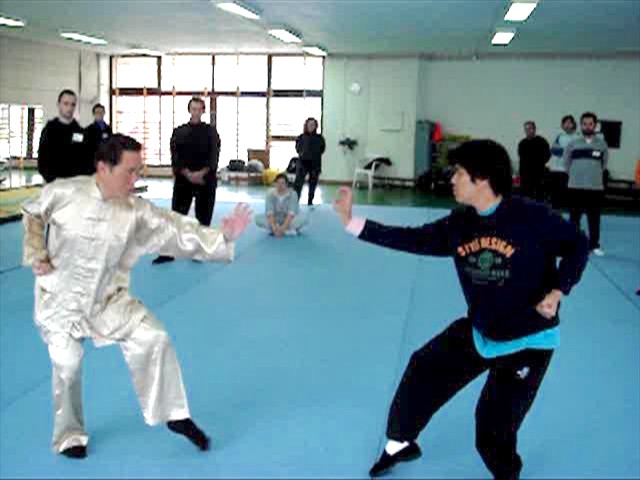 Top, Middle, Bottom
Top, Middle, Bottom
This is the first of the “Eight Simplified Combat Sequences”, and is called “Top, Middle, Bottom” because the initiator attacks an opponent's middle, top and bottom levels, using the Shaolin patterns “Black Tiger Steals Heart”, “Poisonous Snake Shoots Venom” and “Precious Duck Swims Through Lotus”.
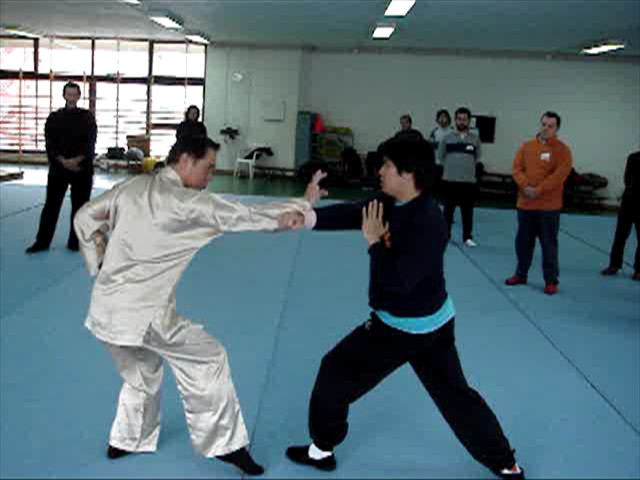 Form, Force and Speed
Form, Force and Speed
Firstly, the patterns are performed with correctness of form. Then they are performed with some force, without sacrificing correctness of form. Thirdly, they are performed with speed, without sacrificing force and form. (The sound heard in the video is due to the contact of the combatants' feet with the floor.)
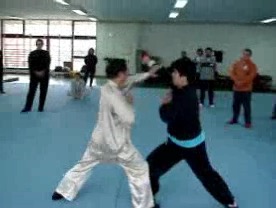 Side Attack
Side Attack
This is the second Simplified Combat Sequence, and is called “Side Attack”. The technique used in the side attack is a “horn punch”, and the pattern is called “Hang A Golden Star at Corner”.
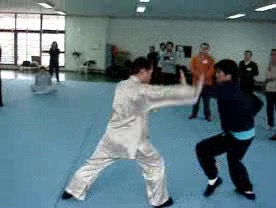 Add Suitable Patterns if Appropriate
Add Suitable Patterns if Appropriate
The sequence is now performed with some speed. When you are familiar with the sequence, if your sparring partner hesitates or makes a mistake, you may continue with any suitable attacks, as Grandmaster Wong demonstrates here. However, his sparring partner, Sifu Wong Chun Nga, is well trained, and is able to respond accordingly.
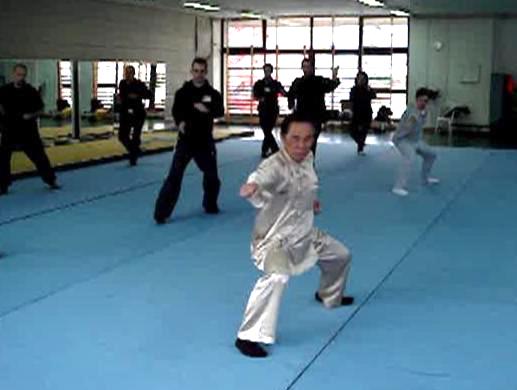 The Six Harmonies
The Six Harmonies
Grandmaster Wong leads the class in practicing the initiator's mode and the responder's mode of Simplified Combat Sequence 1. Pay attention to the “six harmonies” of body, hand, feet, essence, energy and spirit.
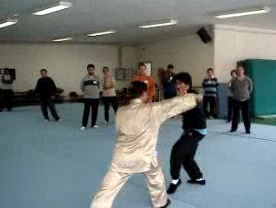 The Method of Continuity
The Method of Continuity
One could link Sequences 1 and 2 together in “Continuity” in our sparring methodology. Notice the footwork used when Sequence 1 is continued to Sequence 2.
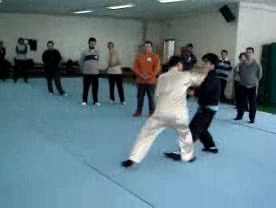 Pressing an Opponent
Pressing an Opponent
Grandmaster Wong demonstrates how you can press an opponent using Sequence 1 and Sequence 2. When the opponent hesitates or is slow, you leave out the related intermediate or defending pattern.
 Continuity by Responder
Continuity by Responder
In an earlier step of our sparring methodology, the initiator continues from the first sequence. Notice the footwork of the responder, performed here by Sifu Wong Chun Nga, as he continues from Sequence 1 (initiated earlier by Grandmaster Wong) to Sequence 2.
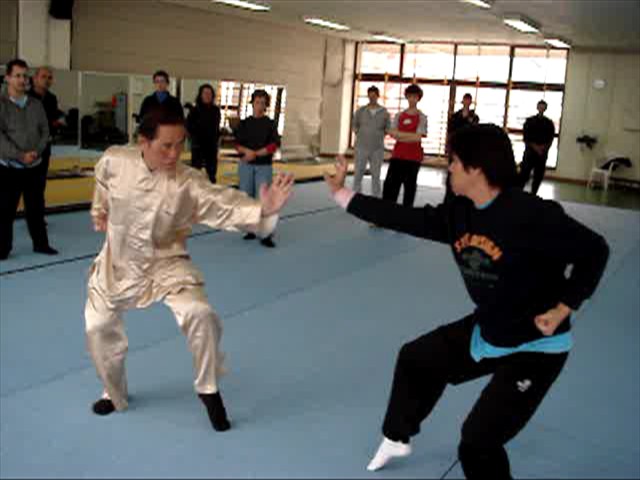 Fluidity and Speed
Fluidity and Speed
Here the two sequences are performed smoothly and fast. Grandmaster Wong initiates with Sequence 1, and Sifu Wong Chun Nga continues with Sequence 2.
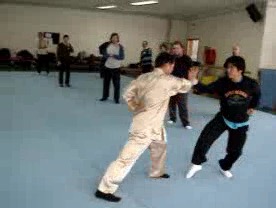 Continuous Attacks
Continuous Attacks
This is Sequence 3, called “Continuous Attacks”, performed slowly. Here the operational mode is “attack-attack”. Can you tell where the continuous attacks occur?
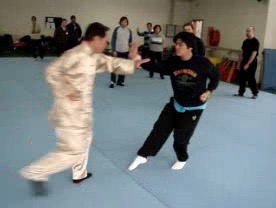 Covering or Opening Guard Hand
Covering or Opening Guard Hand
Sequence 3, which is Continuous Attacks, is now performed at normal speed. Notice that the tactic of continuous attacks is employed by both the initiator and the responder. It is important to cover or open the opponent's guard hand as your move in to continue your attack.
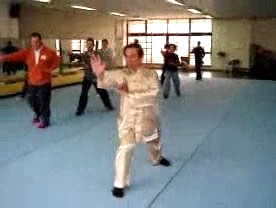 Objectives of Form Training
Objectives of Form Training
Grandmaster Wong leads the class in performing Sequence 2 in solo. Solo form training is an important aspect of kungfu training. Besides familiarizing yourself with the routine of the sequence, it helps you to have correctness of form, to regulate your breathing, to explode force and to practice fluidity of movement.
You can view all the above videos here
From Combat Sequences to Free Sparring
-
Training Combat Sequences to Prepare for Free Sparring
-
Counters against Kicks and Throws
-
Systematic and Gradual Progression to Free Sparring
-
Some Formidable Attacks and their Beautiful Counters
-
Gentle and Elegant, yet Forceful and Combat Effective
LINKS
Courses and Classes
 Shaolin combat application at the regional Shaolin Kungfu Course in Portugal in February 2007
Shaolin combat application at the regional Shaolin Kungfu Course in Portugal in February 2007











